Deer Fly
A deer fly can’t really be labelled as harmless. They survive by sucking the blood of cattle and humans. In one word they are the annoying pests that you want to get rid of. The size of a deer fly lies somewhere between the horse-fly and the housefly. But, it can be a daunting task to locate a deer fly. You know, why? Because it has as many as 250 species. But, if you are anywhere in Hawaii, Greenland, or Iceland then you are safe from the annoying buzz of a deer fly.
What does a deer fly look like?
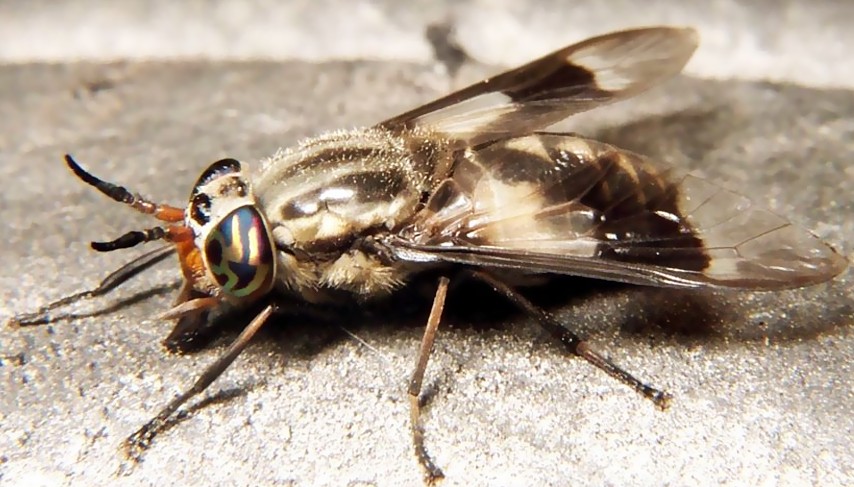
Picture of a Deer fly
In order to distinguish a deer fly from the rest of the innumerable flies, you have to know how it looks like. These horrible and dangerous flies lie somewhere between 5mm to 12mm. They are bigger than the commonly found house flies, but their size is significantly smaller than the horse flies.
You can spot a deer fly once you know their features and appearance; they have brightly colored protruding eyes. It can be either green, gold, blue, or orange in color. Their wings, however, are quite big and black in color. However, their body can be black, or a combination of yellow and black or gray. It has a prominent and quite large mouth that points downward. A deer fly is capable of flying long distances and sucking the blood of cattle, humans, and few other wildlife creatures.
The Behavioral Patterns of a Deer Fly
A group of female deer flies fly together in search of food or blood. These female organisms can cover long distances, but the activity of a male deer fly starts somewhere between May and September. You can spot a deer fly when the sun is shining brightly and there is absolutely no wind. But, their behavioral patterns tend to change according to the temperature, barometric pressure, humidity, and the clouds.
The female deer fly attacks mammals that are warm-blooded. This helps them to provide the nourishment their eggs need. Diseases are spread quite easily by the female deer flies because they feed on multiple host bodies for their need of blood.
The Diet of the Deer Flies
The female deer fly sucks the blood of multiple vertebrae to meet her need for blood. Her major targets are always humans and deer. This helps her to reproduce. It can lay as many as 800 eggs at one time on wet and damp vegetation. The larvae are known to feed itself from the organic matter found in these damp and moist soils. However, the male deer fly doesn’t feed itself on blood. They go after pollen and nectar.
Where are they found?
They can be found anywhere and in short everywhere. If it is wet and warm, then you are sure to come across the deer flies. Deer flies are mostly found in the temperature, terrestrial, and wetland areas of the world.
How does a Deer fly Reproduce?
Reproduction is a part about the life of a deer fly that is still under a lot of scrutiny and discussion. Male deer flies look for their mates by either taking a hovering or non-hovering flight. According to research, females mate only twice in their entire lifetime.
After consuming a blood meal, a female deer fly waits for a minimum of four to eight days. She then lays her eggs in a batch when the temperature is favorable and sunny. The female deer fly brings food for her eggs. This usually occurs somewhere between the months of May and September.
How long can a deer fly live?
A deer fly hardly lives a whole year. The female lays eggs in the summer months, which turns to larva during the winter months; it then converts into the pupa during the early months of summer and dies by late summer.
What is the difference between a Horse-fly and a Deer Fly?
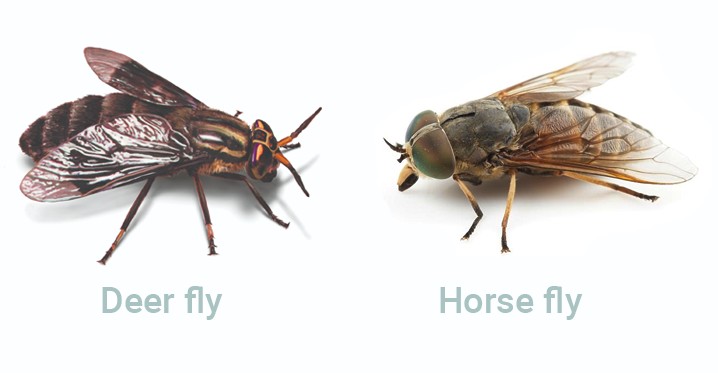
Deer fly vs Horse fly
Both of these flies are bloodsucking pests that go after humans, wildlife, livestock, and other vertebrae. Their bites are extremely painful, and they have the potential to spread a lot of diseases. But, there still lie a lot of prominent differences for you to understand which one is a horse fly and which is the deer fly.
A Horsefly is larger in size and can range from ¾ inches to 1-¼ inches. They have either colorful wings or it is clear. However, their eyes are colored. They attack mostly horses and don’t spread a lot of diseases.
On the other hand, a deer fly loves to feed itself on human blood and have dark bands on their wings. They too have protruding eyes that are colored.
Deer Fly Bite
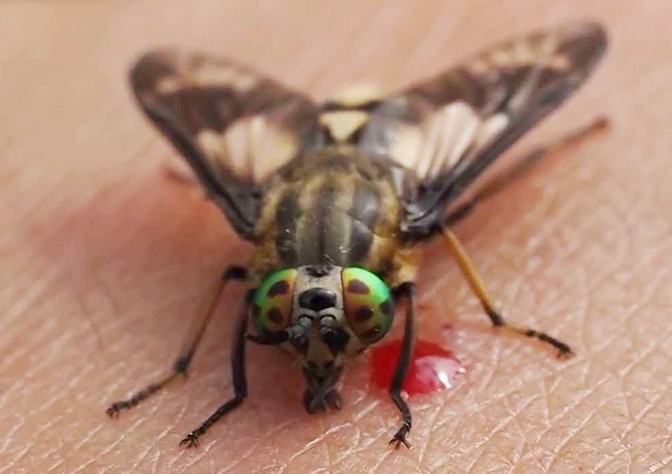
There is no denying that the bite of a deer fly is painful, annoying and yet somehow inevitable. The buzz of one deer fly is enough to break your concentration. Come summer, deer flies are out feeding on the blood of humans. If you live somewhere near the water bodies, then you are bound to come across these mischievous little buggers.
Though a deer fly is only ¼ inches long, it has the power to inflict so much pain that it is beyond anyone’s ability to describe. Their sharp mouth can suck the blood of mammals in no time. Apart from the pain, the bite of a deer fly is pretty dangerous. They have the ability to transmit tularemia, which is a rare kind of bacterial disease. You can face problems like fever, skin ulcers, headaches, and rashes.
To take care of the deer fly bite, clean the area thoroughly with water and a disinfectant soap. This will stop the infection from spreading in your body. Some people are often allergic to the saliva of a deer fly. To take care of the itching and burn like sensation you can apply some ice on the affected area. Don’t forget to get a prescription for allergy medication.
The Importance of a Deer fly
The male deer fly feeds on the pollen and nectar. They are an active part of pollination. Not to forget how different living organisms depend on them for their food requirements. The female deer fly is, however, a parasite that lives and reproduces by sucking the blood of deer, cattle, and humans. They actively transmit diseases by sucking the blood of their hosts. They possess absolutely no benefit to humans. One can suffer from tularemia, anthrax, hog cholera, allergies, anaplasmosis, filariasis, and anemia. Apart from all of these serious diseases transmitted by these blood-sucking monsters they are a complete nuisance in the lives of humans. Swarming in large numbers during the summer months, one can’t possibly stay away from their horrible bites.
How to get rid of Deer flies?
After hearing about the troubles they cause, it is time you know what you can do to keep them away from your home and lives. It is true that a deer fly doesn’t have life-threatening effects, but they do transmit a lot of pain, and it’s time you stop it. Here is a list of things you can try to take care of the problem of deer flies.
Use a natural repellent
If you have used a large number of deer fly repellents sold in the market and found no effective use of them, then it is time to switch to a homemade and natural repellent. Mix all of these ingredients together.
- Vodka – 2 ounces.
- Water – 6 ounces.
- Lemongrass essential oil – 30 drops.
- Eucalyptus essential oil – 30 drops.
Use a spray bottle that can hold up to 8 ounces. First mix the essential oils and the vodka together in the spray bottle. Mix it well. Now, add six ounces of water to the mixture. Go ahead and shake it well again. Make sure you spray it on the exposed areas of your body before you head out. If you don’t have access to vodka, then use witch hazel and vinegar in its place.
Deer flies are attracted to the color blue. Try to wear some other color to stay away from their bites.
Deer flies multiply and breed in moist and sunny areas. You can avoid them by creating more shade in your garden.
The presence of tall grasses and weed growing in your backyard are perfect homes and breeding areas for deer flies. It is time you trim the tall grasses and maintain the look of your garden.
Always keep your pools clean. Once you have cleaned the pool make sure you keep it covered.
Pictures
Collection of pictures of deer flies…
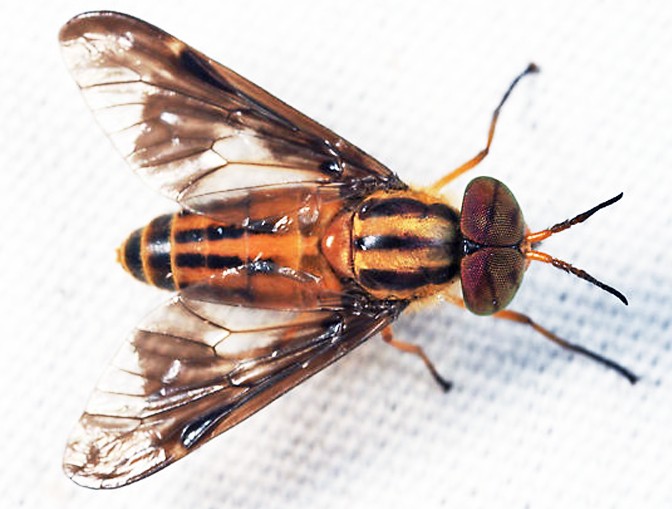

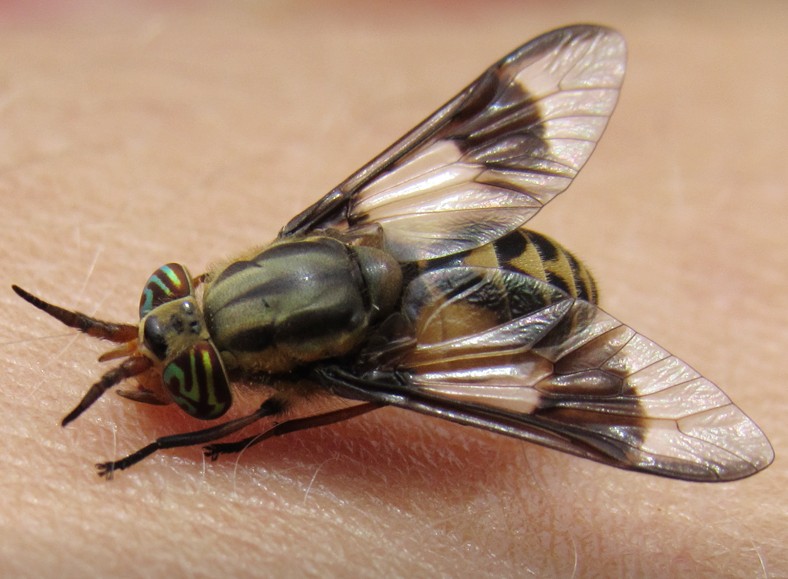
Deer Fly Facts
Some interesting facts about the deer flies:
- Did you know as many as 4300 species of deer flies and horse flies exist in the world?
- If you are ever bitten by a deer fly, then remember that it is a female that did it.
- The deer flies have mouths with sharp blades that can pierce the thick skin of mammals.
- Predators of this annoying bug are killdeer, wasps, dragonflies, hornets, and other birds.
By now you know all about a deer fly and how much they can bother you in between the months of May to September. Stay away from their bites by taking the necessary steps.
